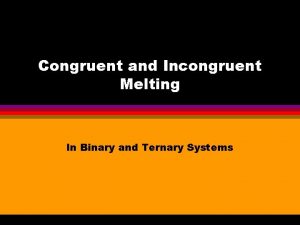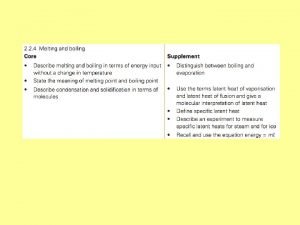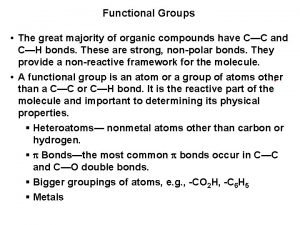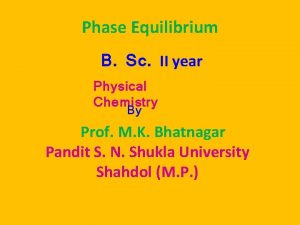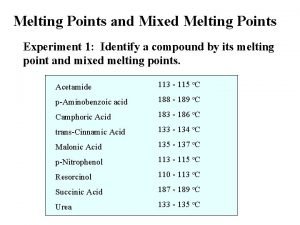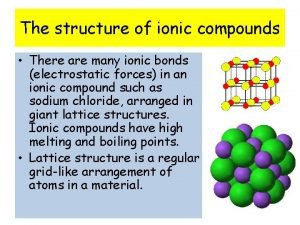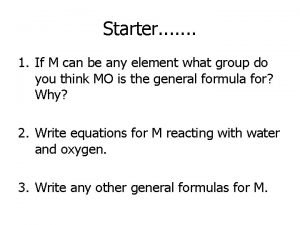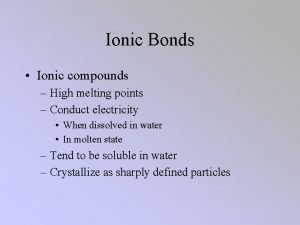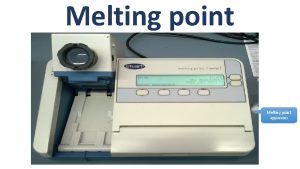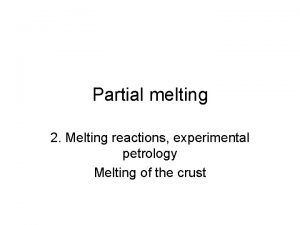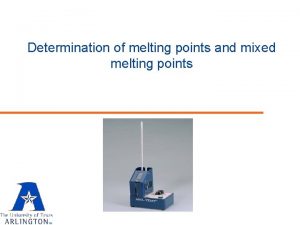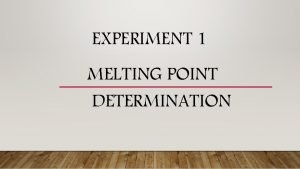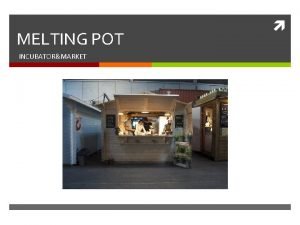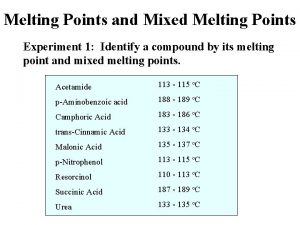Melting Point Determination Definition Melting point Is the















- Slides: 15

Melting Point Determination

Definition Ø Melting point Is the temperature at which a solid is converted to liquid at normal atmospheric pressure. ØA more specific definition of m. p. Is the temperature at which the solid and the liquid phases are at equilibrium at a specific atmospheric pressure). pressure (normally

Ø Is the temperature at which rupture the forces among the crystals of a solid. This results in a change from the crystalline to the amorphous state (irregular state). This change involves the absorption of a characteristic amount of heat called the heat of melting or fusion.

Importance of m. p. 1. It is a physical property used for identification. 2. It is an important indicator for purity. 3. The melting point helps to characterize new compound.

factors affecting melting point (m. p) 1)Molecular weight (M. Wt) or Size of the molecule 2)Impurities 3)Branching 4)Intermolecular interactions like A. Ionic , dipole-dipole attractions B. Van der Waal interactions C. H-bonding

factors affecting melting point (m. p) 1 - Molecular weight (M. Wt) or Size of the molecule

factors affecting melting point (m. p) 2 - Impurities, even when present in small amounts, usually depress the melting point and broaden the melting-point range. A wide melting point range (more than 5° C) usually indicates that the substance is impure; a narrow melting point range (0. 5 -2° C) usually indicates that the substance is fairly pure.

Pure compound, melting impure compound, melting range (1 -2) o. C range >2 o. C

Procedure 1. A small amount of the finely powdered material is placed into a capillary tube that is sealed at one end. 2. The capillary tube is inserted into a melting point apparatus in which the temperature can be measured when heated. 3. To obtain an accurate melting point it is necessary to heat SLOWLY, proceeding through the melting point at no faster than 1°C per minute. 4. Two temperatures are recorded: the temperature at which the substance begins to liquefy and the temperature at which it becomes completely liquefied. The observed melting-point range is the interval between these two temperatures.

The observed melting-point range can be influenced by: 1. The purity of the material but also by the size of the crystals. 2. The amount of material. 3. The density of its packing in the tube. 4. The rate of heating.

NOTE Ø A finite (limit) time is required to transfer heat from a hot liquid through the walls of the capillary tube and throughout the mass of the sample. When the heating fluid is heated too quickly, its temperature rises several degrees during the time required for melting to occur. This can result in an observed range that is higher than the true one. When the temperature of the heating fluid approaches the melting point of the sample, it is essential or good results to raise the temperature slowly and at a uniform rate, about 1 -2°C/min.

Ø The sample should be small, finely powdered, and packed tightly in a thin-walled capillary tube of small diameter. The column f solid in the capillary tube should be just high enough to be seen clearly during melting (about 1 -2 mm).

Tap the closed end gently on the bench to pack the solid at the bottom The sample should be tightly packed

Apparatus

 Incongruently melting compound
Incongruently melting compound Boiling point and melting point
Boiling point and melting point Ion solvent interaction
Ion solvent interaction Discuss the phase diagram of ferric chloride water system
Discuss the phase diagram of ferric chloride water system Melting point
Melting point Shipping point determination
Shipping point determination Shipping point determination sap
Shipping point determination sap Boiling point determination experiment
Boiling point determination experiment Manifestation determination process
Manifestation determination process Sex reversal
Sex reversal Ionic compound
Ionic compound Melting and boiling point of
Melting and boiling point of Flame colours of group 2 elements
Flame colours of group 2 elements Melting point of group 2
Melting point of group 2 Difference between metal oxides and non metal oxides
Difference between metal oxides and non metal oxides Why do ionic compounds have high melting and boiling points
Why do ionic compounds have high melting and boiling points
